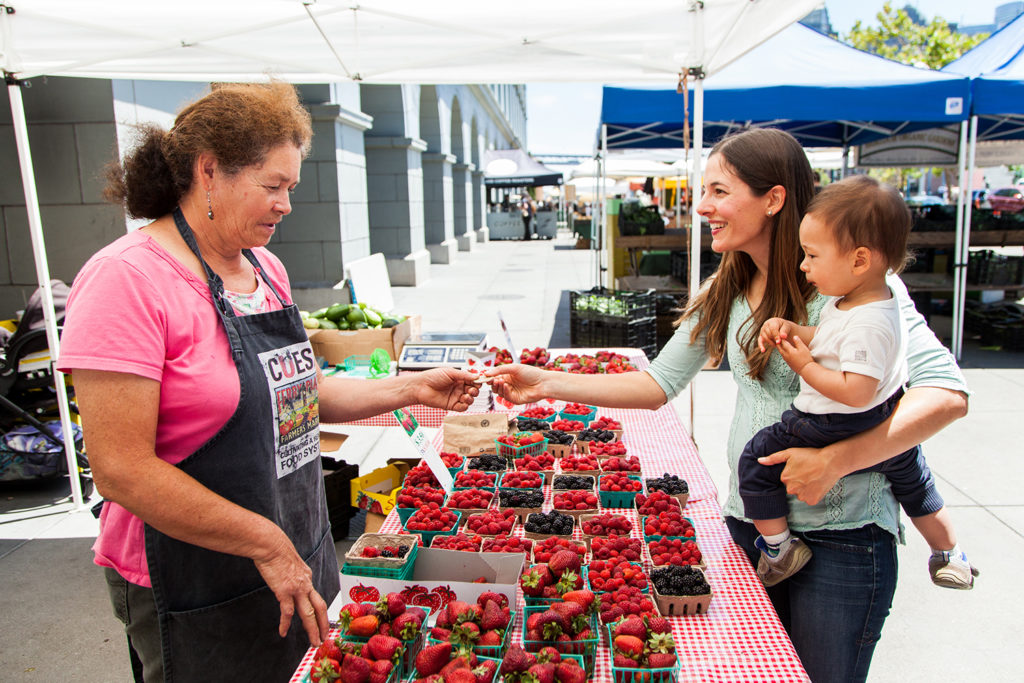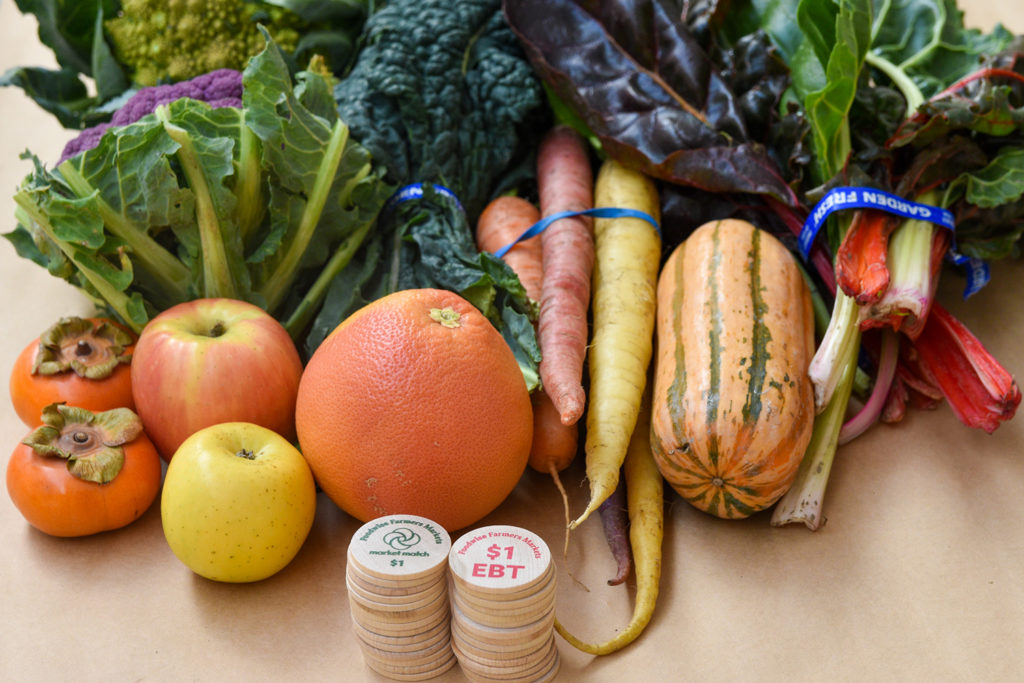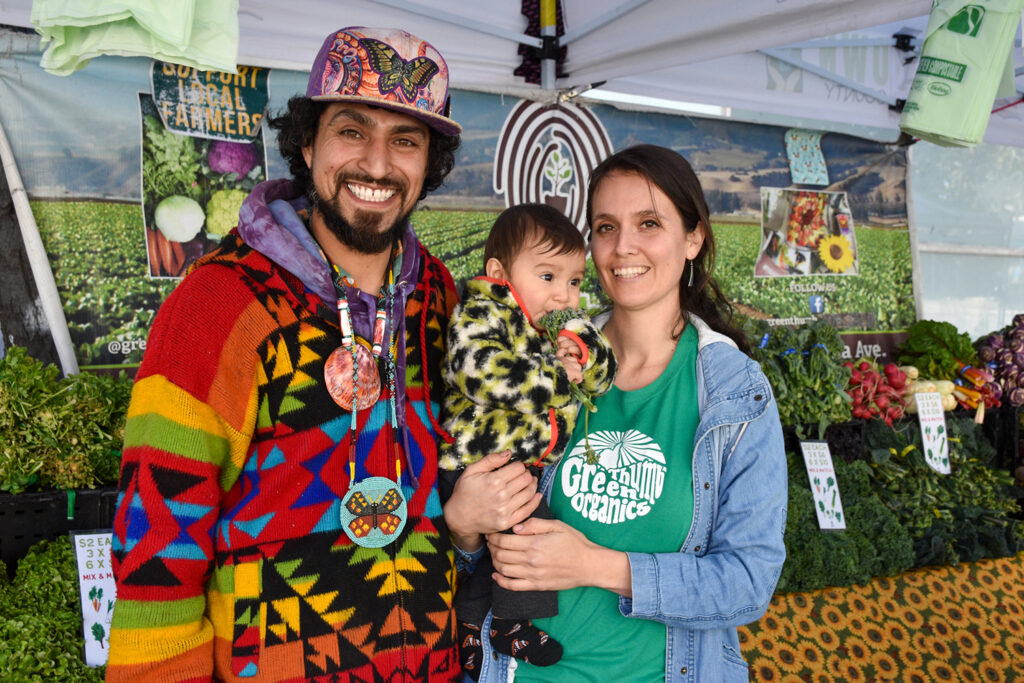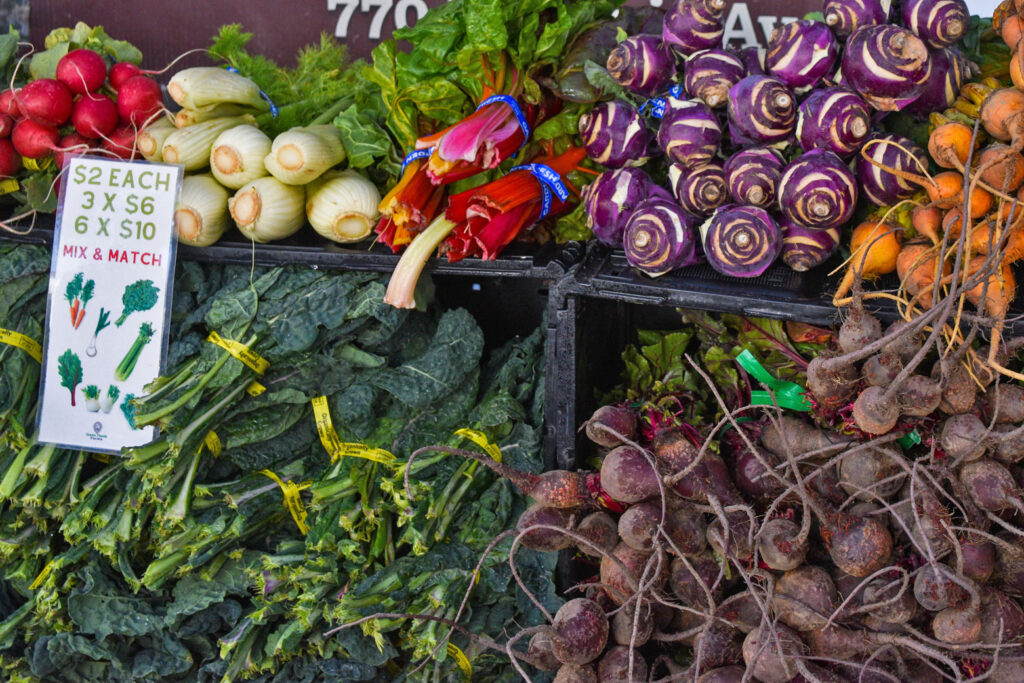As SNAP Benefits Are Cut, Market Match Helps Bridge the Fresh Food Access Gap
Selina Knowles, Communications Coordinator
April 28, 2023

During the pandemic, the federal government increased SNAP (Supplemental Nutrition Assistance Program) benefits to help individuals in need, and as a result, many started using their benefits at the farmers market for the first time. After three years, these emergency pandemic boosts expired at the beginning of April, leaving many families at risk for food insecurity amidst inflation and rising food costs.
At Foodwise farmers markets and markets across California, shoppers can double their CalFresh (California SNAP benefits) with Market Match by swiping their EBT card at the Info Booth and receiving free tokens to spend on fresh produce. With CalFresh Awareness Month approaching in May, we talked with shoppers, farmers, and Market Match administrators about the impact of this massive cut to benefits and the lasting importance of CalFresh and Market Match for fresh food access and a thriving local food system.

Getting More Healthy Food with CalFresh at the Farmers Market
Over the last three years, CalFresh benefits increased to meet the needs of Californians impacted by the pandemic. At Foodwise farmers markets alone, CalFresh usage tripled, with many shoppers maximizing their benefits with Market Match, which matches CalFresh benefits up to $10 per market day.
“During the pandemic, we saw a lot of new faces at the farmers market who were really grateful to have this program available,” Foodwise Director of Operations Lulu Meyer says. “Those folks have since become some of our most dedicated regular shoppers, and have developed relationships with the farmers and our market staff.”
For shoppers on a tight food budget, Market Match allows them to have agency in their diet, while shopping locally. Lulu says that Market Match encourages more people to come to the farmers market, interact with the farmers directly, and try new things they may not normally gravitate to.
Alla shops at the Ferry Plaza Farmers Market every Saturday. Before learning about Market Match, she was hesitant to spend money on the organic food she wanted, but Market Match opened up more options for Alla and shifted her perspective on what foods she could buy. She says, “We would buy the cheapest and non-organic… Market Match was the change. And now we eat all organic.”
In addition to the food that she purchases with CalFresh, Alla returns to the farmers market regularly for “the atmosphere and also the salesmen. I practically know everyone by name.”
Other shoppers use Market Match to round out their diet. One weekly Ferry Plaza shopper, who asked to remain anonymous, says, “I use the EBT coins for meat, and it’s really nice to be able to then get the produce on the side, complimentary of Market Match. That’s really helpful.”

Market Match Helps Sustain Small Family Farms
While Market Match helps low-income shoppers stretch their budget for fresh fruits and vegetables, it also supports small and mid-sized farmers who rely on income from farmers markets. “It’s not just the customers receiving that benefit,” says Heidi Kliener, Market Match Program Manager at the Berkeley-based Ecology Center, which administers the program in California. “It does have an economic benefit to the small and mid-sized farms around the state.”
At Foodwise’s farmers markets, Lulu says, “It’s been so amazing to see how the program has increased the number of shoppers we have at even our quietest market days.” During this especially rainy winter season, farmers and food makers saw an overall decrease in foot traffic at farmers markets, so Market Match usage helped to fill some of that gap.
With Market Match specifically incentivizing shoppers to buy fresh fruits and vegetables, the record high use has been especially good for small farmers. The extra dollars also encourage shoppers to explore the farmers market with an open mind.

Educating shoppers about less familiar produce and supporting them in getting the most value for their dollar are built into Green Thumbs Farms’ business model. Farmer Rudy Jimenez operates on four acres in San Juan Bautista, and he relies on farmers markets for most of the farm’s income.
Shoppers can mix and match vegetable bunches at Green Thumbs’ stand, saving when they buy more. Rudy says, “With the mix and match, we encourage shoppers to take something that they’ve probably never tried. And that’s my goal: for them to step out of their comfort zone and try something new.”
About shoppers who utilize Market Match, he says, “We just want to encourage everybody to be able to use whatever money that they have access to, so they feel welcome.”

Market Match Depends on Federal Funding—and Community Support
In April, pandemic boosts to benefits were cut, impacting 12% of San Francisco residents. With the average household on CalFresh losing about $200 a month, more families are relying on other food access programs, like Market Match, and tightening their budgets.
“I’m definitely buying less of the things I want and more of the things I need,” says the aforementioned anonymous shopper.
“Without EBT, or without the Market Match, a lot of us don’t have as much incentive to come back,” says Julia, a weekly shopper who uses EBT. “Market Match is really important because it doesn’t just benefit EBT users, but also the people who make the farmers market possible.”
It’s estimated that for every $1 invested in Market Match, an additional $3 is generated in the local economy. But Market Match relies on state and federal funding, and market operators like Foodwise fundraise to supplement those funds as demand for the program grows.
Minehaha Forman, Ecology Center’s Food and Farming Program Director, explains that the Market Match program has been operating for the past 12 years through funding from the California Department of Food and Agriculture that is matched by the USDA. That reliance on federal funds could put the program at risk.
“The state budget has a big deficit right now,” she says. “They’re looking at things to cut, and the California Department of Agriculture’s match that is required to get the federal funding may be reduced or cut completely.” Up for renewal this year, the Farm Bill establishes how much funding out of the bill’s $700 billion will be allocated to nutrition programs over the next five years.
Record high CalFresh usage since 2019 has demonstrated that demand is exceeding the funding available, according to Lulu. “While we receive some funds from the California Market Match Consortium for the program, Foodwise, like many other California-based organizations, has far exceeded those federally granted funds needed to facilitate the program.”
In order to keep Market Match going year-round for the thousands of Bay Area residents who depend on it to put fresh food on the table, Foodwise relies on support from individual donors and foundations. If you’re interested in supporting your Bay Area neighbors and the livelihoods of local farmers, you can share the following food access resources and consider becoming a recurring Foodwise donor or making a donation today.
Learn more about CalFresh and Market Match. Here are 10 ways to stretch your food budget at the farmers market and where to find additional food money and support.
To support food access programs like Market Match, consider becoming a Foodwise Sustainer. Become a new monthly donor at $30 or more by May 22 to receive a free gift.
Thank you to Sisters of the Holy Family and Bi-Rite Family of Businesses for their critical support of the Market Match program.
Topics: Food access, Food justice, Nutrition, Programs
